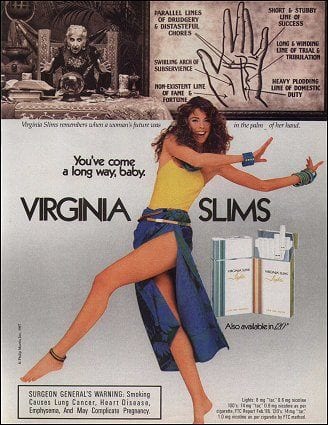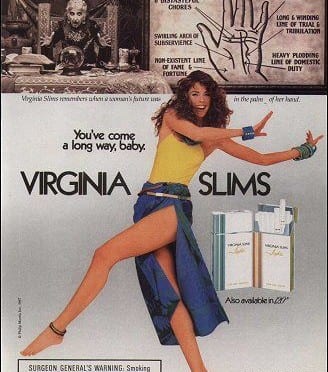Looking at how far images of women in advertising have come since the middle of the 20th century is to see a move from the middle of nowhere into the mainstream. This reflects the progress of women in society as a whole, but in advertising — as elsewhere — it was neither easy nor fast.
The booming economy, population explosion and the escalation of mass media after World War II produced a kind of perfect storm for advertising. Understanding that women held the purse strings on domestic spending, advertisers targeted housewives.
But the 1950s portrayals were one-dimensional, as “women were almost always seen in the kitchen, wearing aprons and waiting on their families,” explains Tina Pieraccini, a communication studies professor at SUNY Oswego whose publications include “You’ve Come A Long Way, Baby,” which examined decades of media images of women. “TV entertainment programs were family comedies and the women in ads mirrored those perfect housewives as seen on ‘Leave it to Beaver,‘ ‘Father Knows Best‘ and the ‘Donna Reed Show.”
The sexual revolution of the 1960s shook gender identity. As a result, “more sexually provocative ads emerged and women were depicted as sex objects,” Pieraccini says. On TV, painted dancing women on “Laugh In” brought a new type of female form into living rooms, while movie depictions like Jane Fonda’s sexually charged heroine in “Barbarella” seemed light years away from June Cleaver. A Virginia Slims ad even tried to package smoking as sexy and rebellious with the “You’ve Come A Long Way, Baby” campaign.

But the 1970s really brought a bigger shift in how advertisers tried to reach women. “Ads showed ‘women could bring home the bacon, fry it up in a pan and never let him forget he’s a man,’” Pieraccini says, referencing an infamous Enjoli ad (which even drew protests from the National Organization for Women). Women could finally be depicted as doing it all, even if the images tended to prove unrealistic, she adds.
The 1980s finally achieved more of a balance. As “Mr. Mom” became a box-office hit, commercials at last showed, and tried to reach, career women. ” One American Express campaign saw working moms at baseball games in tweed suits with briefcases — but at least the advertisers were trying to show women were more than homemakers,” Pieraccini notes.
By the 1990s and the rise of cable, which eventually brought women-oriented networks like Lifetime and Oxygen, more realistic depictions became a necessity for the advertising industry. One continued change involves increased inclusion of minorities in campaigns. Yet even these may be running behind; particularly as the U.S. Latino population rises above 15 percent, they remain underrepresented in popular culture.
But advertising itself has changed to meet a more media-savvy market. In the book “Marketing to Generation X,” Karen Ritchie observes that the younger generation liked advertising, but abhorred hype as well as “overstatement, self-importance, hypocrisy” and other puffery used to sell products for generations. The sudden and dubious “discovery” of this generation in the early 1990s led to a barrage of unsuccessful advertisements Ritchie describes as “slicker and more superficial than a Coke commercial.
Douglas Coupland, whose novel inadvertently supplied the unfortunate label for Generation X, also thought advertisers faced an uphill climb with younger consumers. “Marketers have known that to pump money out of baby boomers, all they need do is play a Beach Boys song and show a clip from Vietnam,” he sneered in a 1995 article in Details magazine titled Generation
X’d “With X, they naively continue to assume that any generation actively enjoys participating in its own selling out. Wrong.”
In the resulting mood, advertisers mostly have sought either realistic slice-of-life depictions or over-the-top farce. This year’s Super Bowl commercials featured the cartoonish violence of a Bud Light commercial showing a pretty blonde being squashed by an overzealous opponent in a game of backyard football. While people in Super Bowl parties everywhere — mine included — gasped, Bud Light reps could make the (highly dubious) claim that this showed women as equal targets to men (as the opponent is later flattened by the blonde in a bar at the commercial’s close).
Another change is the increasingly popular role of emotion in advertising. I teach a course on Media Copywriting which this semester happens to be overwhelmingly female. I asked the class which they found more effective in advertising: emotion or facts? It wasn’t close. As a matter of fact, it was unanimous: Emotion hooks them the best.
Looking at the assignments students create, it’s clear that housewives and even the beer-commercial sexpots are no longer truly in vogue, let alone the pages of Vogue. Some students’ ads will feature glamorous women — that fantasy element remains tantalizing, especially for those in college — but their examples of women tend to be strong, smart and reflect the world at large.
Pieraccini notes this shift in current advertising. She believes the beer ads and Pizza Hut commercials starring Jessica Simpson are balanced by commercials showing women buying cars and houses as well as the remarkable anti-glamour “Real Beauty” campaign from Dove.
Dove campaign
As opposed to concentrating solely on pretty young things, advertisers are showing middle age can be beautiful too. “Christie Brinkley and Cheryl Tiegs were brought out of retirement after they were dropped after they hit 40,” Pieraccini explains. “Advertisers recognize baby boomers are still spending money but their primary target will continue to be young women — especially young career women with money to spend, the baby boomers’ daughters.”
Looking back at the history of women in advertising, it’s apparent that media depictions have never been more realistic (relatively speaking) or multifaceted. But challenges remain. Countless rap videos continue to depict women as little more than gyrating wallpaper. Brewers and others continue to equate women as prizes one can obtain by using their product. Equality in popular culture, opportunities and pay remains elusive.
So while we have come a long way in some areas, we have not reached any final destination. Consumers and creators should use their clout to assure things continue to move in the right direction.


Leave a Reply
You must be logged in to post a comment.